An Intelligent Redesign Method for Used Products Based on Digital Twin
Abstract
:1. Introduction
2. Redesign Process Framework and Feature Analysis
2.1. Redesign Process Framework of Used Products
2.2. Analysis of Features of the Redesign Process
2.2.1. The Uncertainty of Used Product Information
2.2.2. Customization of the Product
2.2.3. Integration of Redesign Process
3. Intelligent Redesign Framework Based on Digital Twin
3.1. Digital-Twin-Driven Redesign Process Framework
3.2. The Construction Process of DT-Driven Redesign System
4. Application of Redesign Process Based on DT
4.1. Virtual Model Construction for Used Products
4.2. Product Function Planning Based on DT
4.3. Solving Process of Structural Parameters Based on DT
4.4. Design of Remanufacturing Process Scheme Based on DT
5. Case Study
6. Conclusions and Future Work
Author Contributions
Funding
Institutional Review Board Statement
Informed Consent Statement
Data Availability Statement
Acknowledgments
Conflicts of Interest
References
- Jiang, Z.; Jiang, Y.; Wang, Y.; Zhang, H.; Cao, H.; Tian, G. A hybrid approach of rough set and case-based reasoning to remanufacturing process planning. J. Intell. Manuf. 2019, 30, 19–32. [Google Scholar] [CrossRef]
- Ke, C.; Jiang, Z.; Zhang, H.; Wang, Y.; Zhu, S. An intelligent design for remanufacturing method based on vector space model and case-based reasoning. J. Clean. Prod. 2020, 277, 123269. [Google Scholar] [CrossRef]
- Gong, Q.-S.; Zhang, H.; Jiang, Z.-G.; Wang, H.; Wang, Y.; Hu, X.-L. Nonempirical hybrid multi-attribute decision-making method for design for remanufacturing. Adv. Manuf. 2019, 7, 423–437. [Google Scholar] [CrossRef]
- Wang, H.; Jiang, Z.; Zhang, H.; Wang, Y. A Dynamic Information Transfer and Feedback Model for Reuse-oriented Redesign of Used Mechanical Equipment. Procedia CIRP 2019, 80, 15–20. [Google Scholar] [CrossRef]
- Du, Y.; Cao, H.; Chen, X.; Wang, B. Reuse-oriented redesign method of used products based on axiomatic design theory and QFD. J. Clean. Prod. 2013, 39, 79–86. [Google Scholar] [CrossRef]
- Jiang, X.; Song, B.; Li, L.; Dai, M.; Zhang, H. The customer satisfaction-oriented planning method for redesign parameters of used machine tools. Int. J. Prod. Res. 2018, 57, 1146–1160. [Google Scholar] [CrossRef]
- Cao, H.; Chen, X.; Xu, L.; Ma, E. A reuse-oriented redesign method of used machine tool based on matter-element theory. Int. J. Precis. Eng. Manuf. 2014, 15, 921–928. [Google Scholar] [CrossRef]
- Cong, L.; Zhao, F.; Sutherland, J.W. Product Redesign for Improved Value Recovery via Disassembly Bottleneck Identification and Removal. Procedia CIRP 2017, 61, 81–86. [Google Scholar] [CrossRef]
- Hao, B.; Xu, D.; Zhou, J. Research on Intelligent Design Method of Complex Products. In Proceedings of the 2019 2nd WCMEIM, Shanghai, China, 22–24 November 2019; pp. 580–583. [Google Scholar] [CrossRef]
- Li, P.; Ren, Y.; Yan, Y.; Wang, G. Intelligent product-gene acquisition method based on K-means clustering and mutual information-based feature selection algorithm. Artif. Intell. Eng. Des. Anal. Manuf. 2019, 33, 469–483. [Google Scholar] [CrossRef]
- Liu, X.; Tang, L.; Yi, Y.; Ni, Z. Intelligent design based on holographic model using parametric design method. J. Ambient. Intell. Humaniz. Comput. 2018, 10, 1241–1255. [Google Scholar] [CrossRef]
- Qin, H.; Jin, J.; Zhang, Y.; Hu, S. Intelligent Design Based on Knowledge Capture and Reuse. IOP Conf. Series: Mater. Sci. Eng. 2020, 831, 012008. [Google Scholar] [CrossRef]
- Lu, Y.; Liu, C.; Kevin, I.; Wang, K.; Huang, H.; Xu, X. Digital Twin-driven smart manufacturing: Connotation, reference model, applications and research issues. Robot. Comput.-Integr. Manuf. 2020, 61, 101837. [Google Scholar] [CrossRef]
- Polini, W.; Corrado, A. Digital twin of composite assembly manufacturing process. Int. J. Prod. Res. 2020, 58, 5238–5252. [Google Scholar] [CrossRef]
- Fera, M.; Greco, A.; Caterino, M.; Gerbino, S.; Caputo, F.; Macchiaroli, R.; D’amato, E. Towards Digital Twin Implementation for Assessing Production Line Performance and Balancing. Sensors 2019, 20, 97. [Google Scholar] [CrossRef] [Green Version]
- Mukherjee, T.; DebRoy, T. A digital twin for rapid qualification of 3D printed metallic components. Appl. Mater. Today 2019, 14, 59–65. [Google Scholar] [CrossRef]
- Wang, J.; Ye, L.; Gao, R.X.; Li, C.; Zhang, L. Digital Twin for rotating machinery fault diagnosis in smart manufacturing. Int. J. Prod. Res. 2018, 57, 3920–3934. [Google Scholar] [CrossRef]
- Wang, Y.; Wang, S.; Yang, B.; Zhu, L.; Liu, F. Big data driven Hierarchical Digital Twin Predictive Remanufacturing paradigm: Architecture, control mechanism, application scenario and benefits. J. Clean. Prod. 2020, 248, 119299. [Google Scholar] [CrossRef]
- Tao, F.; Qi, Q. Make more digital twins. Nature 2019, 573, 490–491. [Google Scholar] [CrossRef] [Green Version]
- Liu, Q.; Zhang, H.; Leng, J.; Chen, X. Digital twin-driven rapid individualised designing of automated flow-shop manufacturing system. Int. J. Prod. Res. 2018, 57, 3903–3919. [Google Scholar] [CrossRef]
- Zhang, H.; Liu, Q.; Chen, X.; Zhang, D.; Leng, J. A Digital Twin-Based Approach for Designing and Multi-Objective Optimization of Hollow Glass Production Line. IEEE Access 2017, 5, 26901–26911. [Google Scholar] [CrossRef]
- Schleich, B.; Anwer, N.; Mathieu, L.; Wartzack, S. Shaping the digital twin for design and production engineering. CIRP Ann. 2017, 66, 141–144. [Google Scholar] [CrossRef] [Green Version]
- Tao, F.; Sui, F.; Liu, A.; Qi, Q.; Zhang, M.; Song, B.; Guo, Z.; Lu, S.C.-Y.; Nee, A.Y.C. Digital twin-driven product design framework. Int. J. Prod. Res. 2018, 57, 3935–3953. [Google Scholar] [CrossRef] [Green Version]
- Albano, L.D.; Suh, N.P. Axiomatic design and concurrent engineering. Comput. Des. 1994, 26, 499–504. [Google Scholar] [CrossRef]
- Ke, C.; Jiang, Z.; Zhu, S.; Wang, Y. An integrated design method for remanufacturing process based on performance demand. Int. J. Adv. Manuf. Technol. 2022, 118, 1–15. [Google Scholar] [CrossRef]
- Xiao, Y.; Li, B.; Gong, Z. Real-time identification of urban rainstorm waterlogging disasters based on Weibo big data. Nat. Hazards 2018, 94, 833–842. [Google Scholar] [CrossRef]


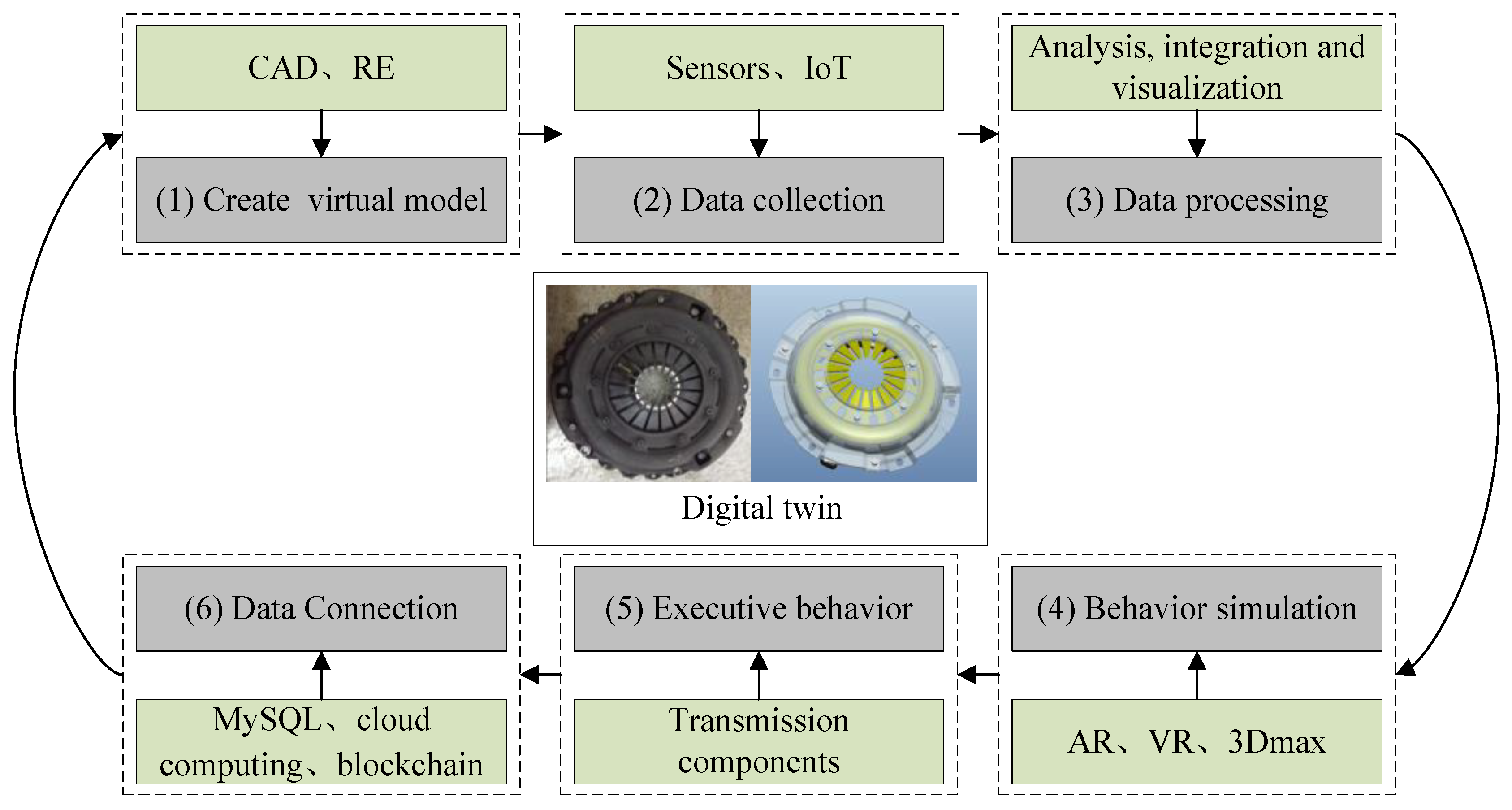
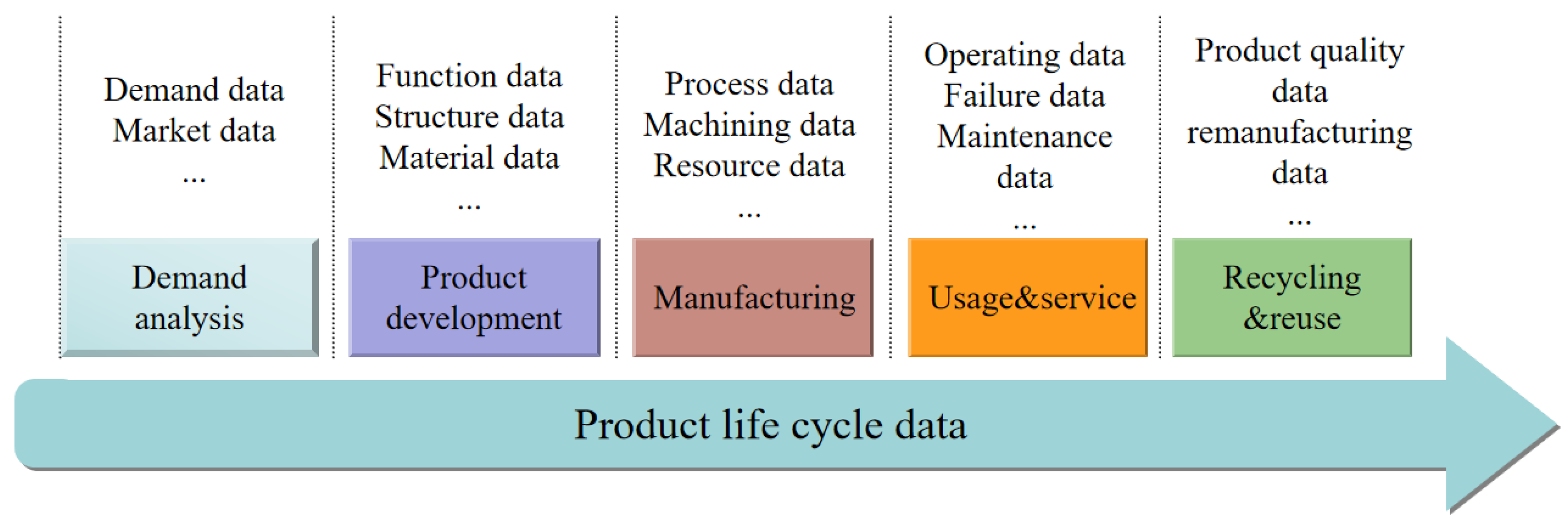

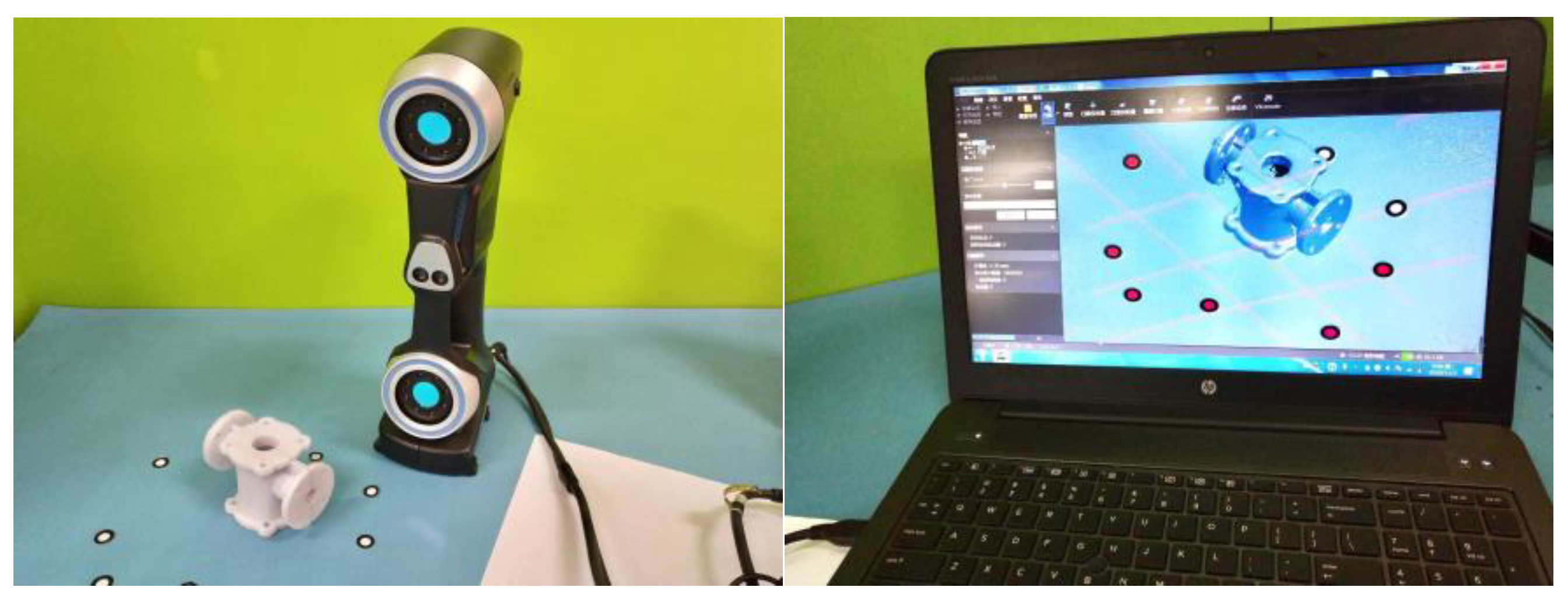
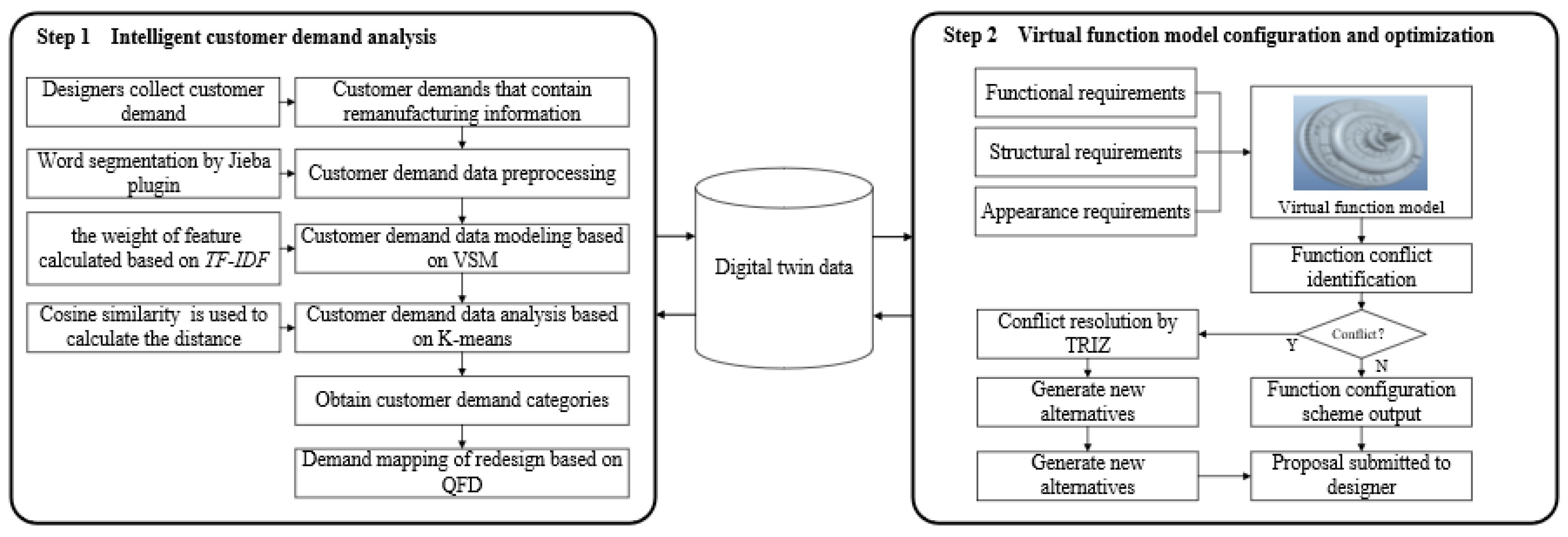
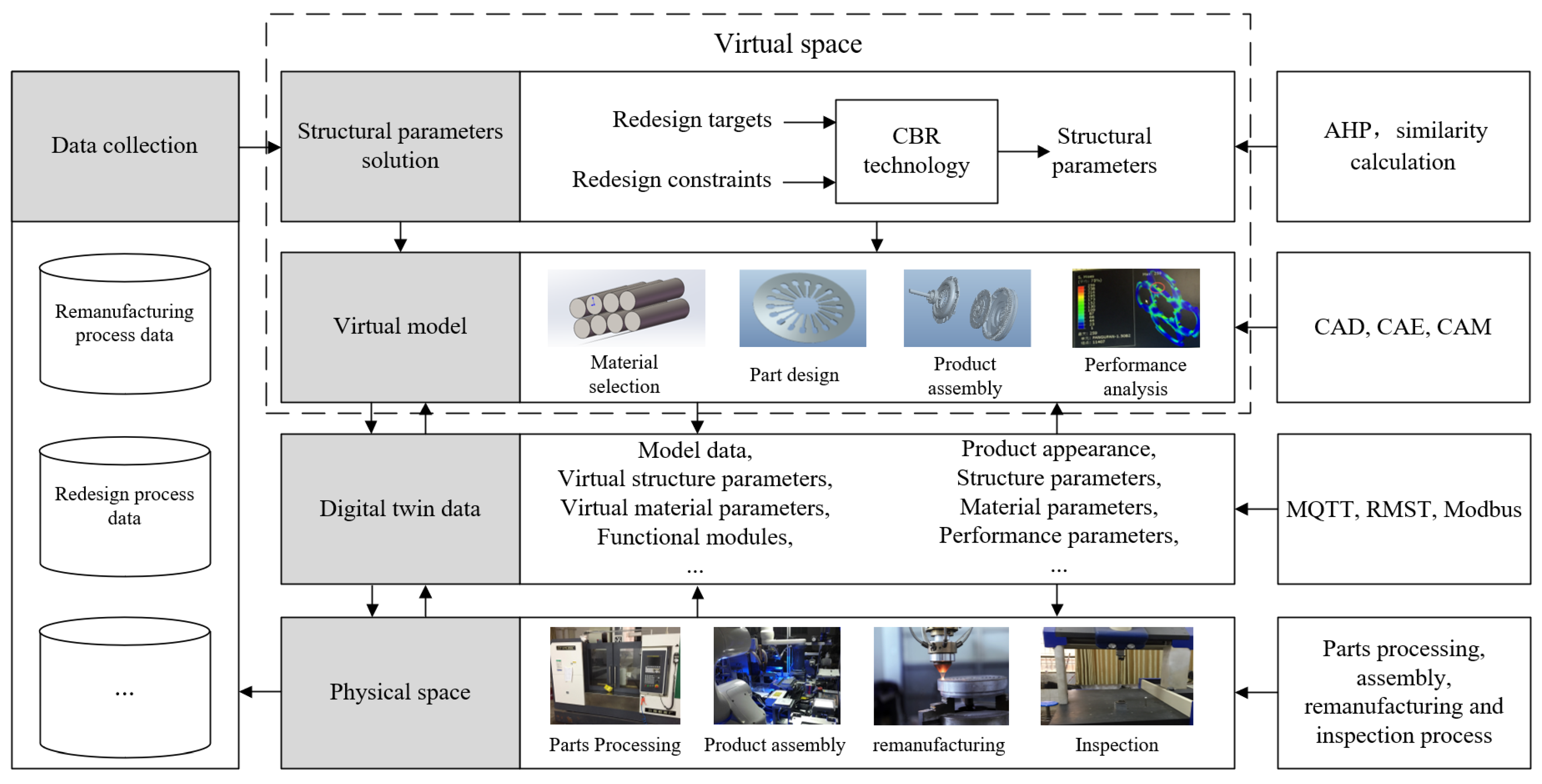


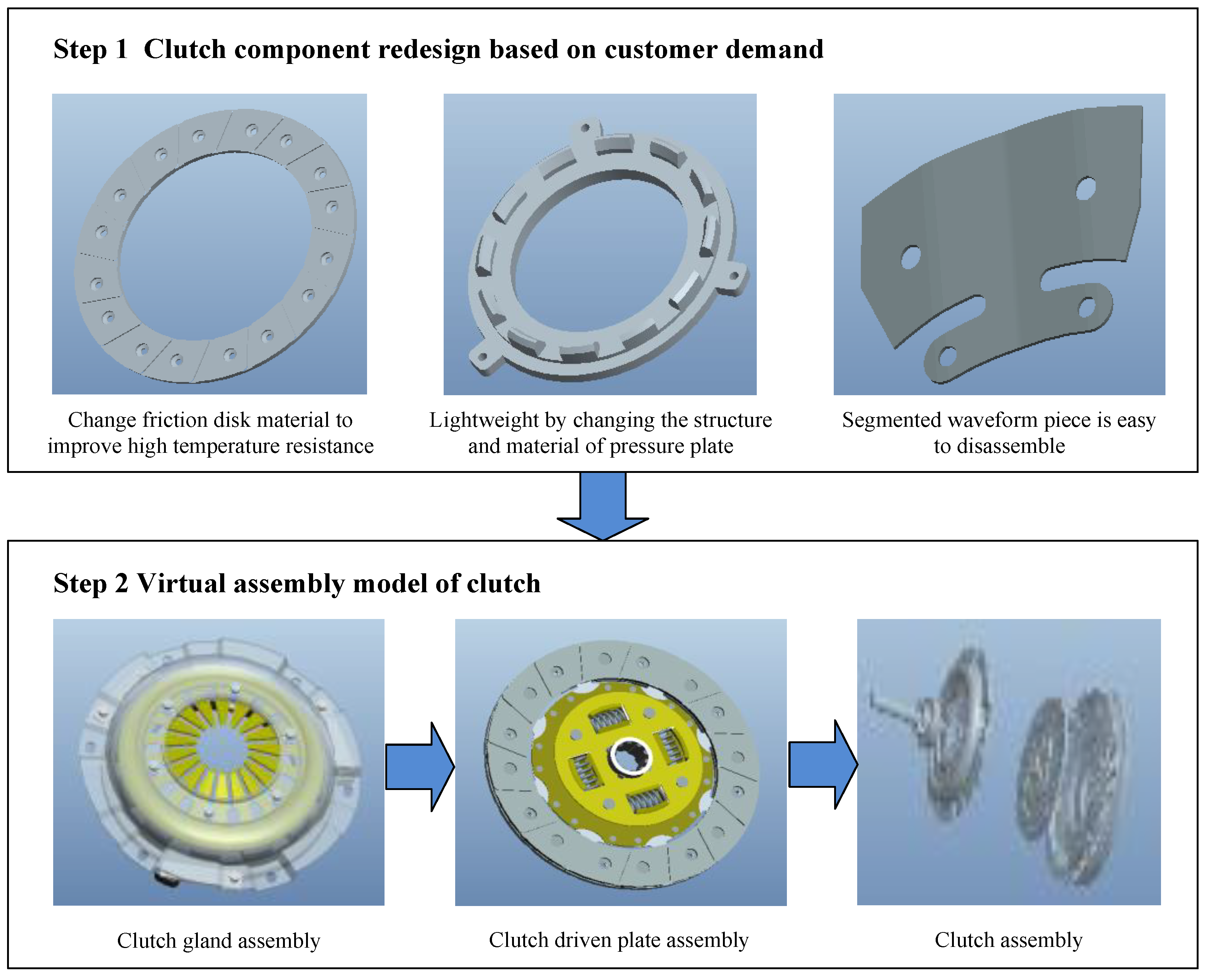
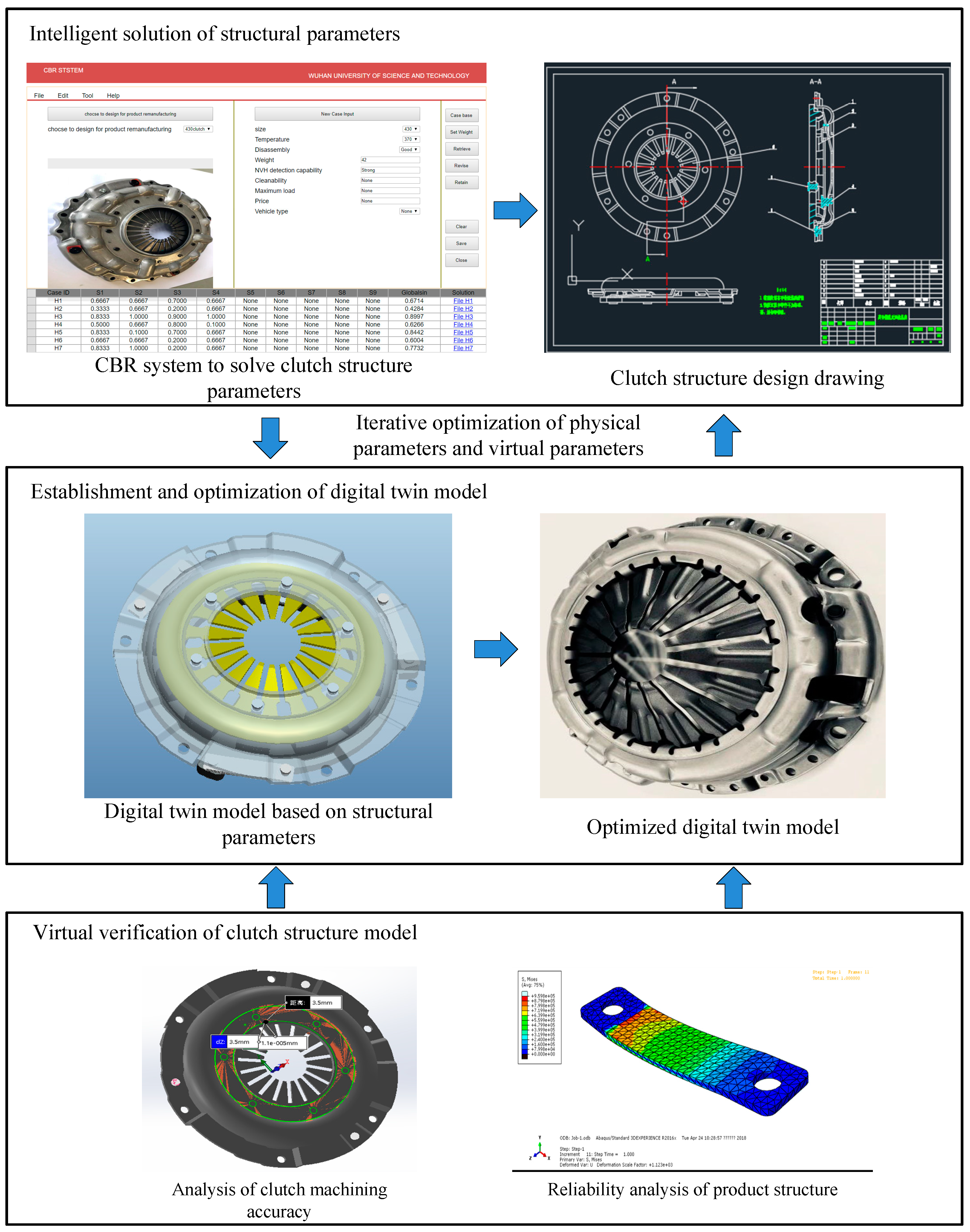
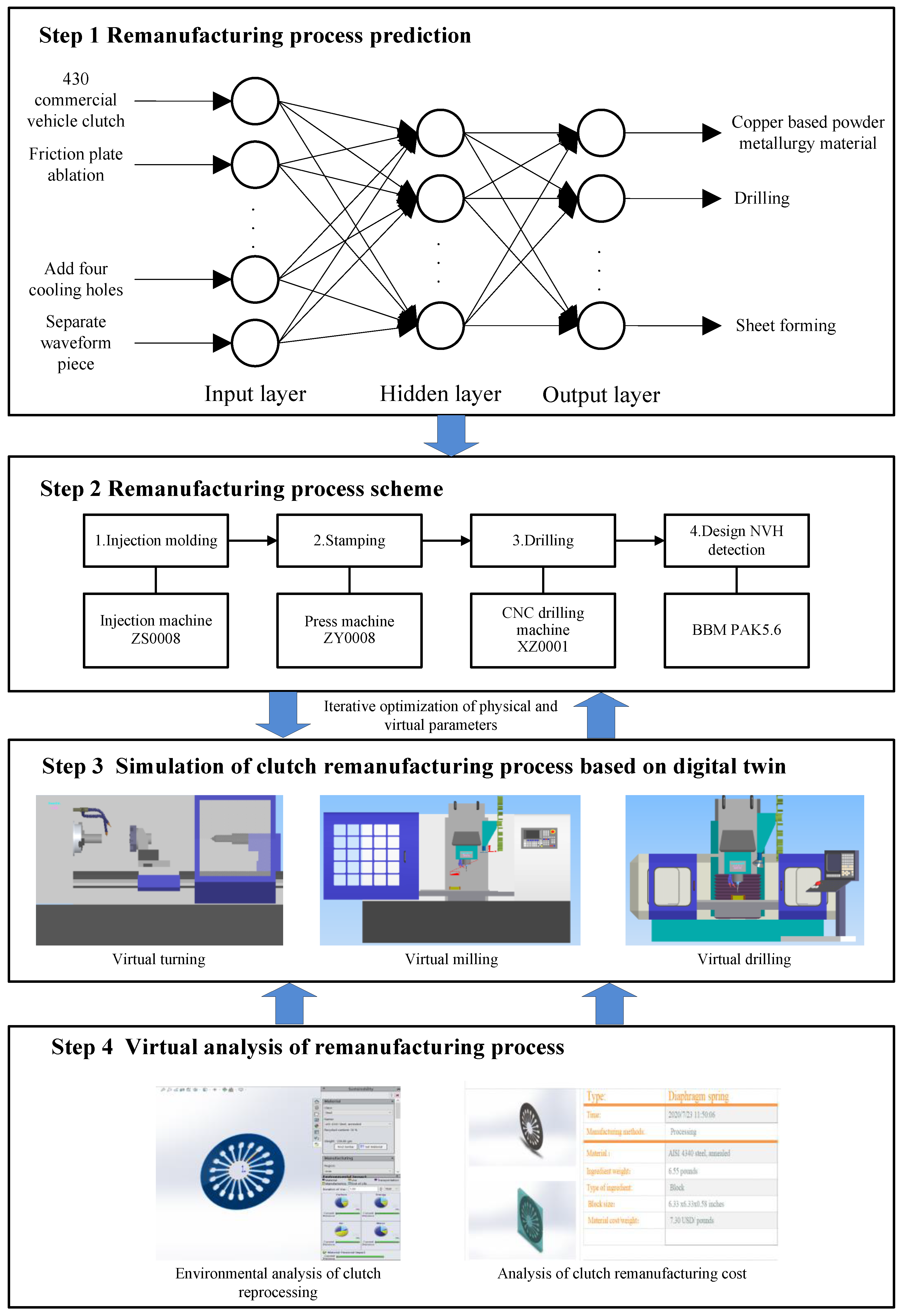
| Serial Number | Demand Text | Cluster Number |
|---|---|---|
| 1 | Clutch coupling smelly, improve high temperature resistance Clutch coupling, ablation phenomenon, change material … Clutch friction plate ablation cohere, difficult separate | 325 |
| 2 | Clutch remanufacturing disassembly, structure go against disassembly, change the connection method Clutch remanufacturing less scheme, parts large waste … Clutch remanufacturing driven plate, bad disassembly change structure | 205 |
| 3 | Clutch separate halfway, possible heavy, reduce material Clutch heavy, hope can lightweight … Clutch material loss, reduce weight | 168 |
| 4 | Clutch abnormal noise, hope provide NVH test Vehicle front abnormal noise, hope cooperate solve … Vehicle put into gear difficulty, cooperate adjust | 196 |
| Customer Demand | Ablation | Difficulty in Disassemble | Heavy Weight | Abnormal Noise |
|---|---|---|---|---|
| Weighted value | 0.325 | 0.205 | 0.168 | 0.196 |
| Engineering characteristic | Withstand temperature 360 °C | Good disassembly | Clutch weight ≤ 45 kg | Strong NVH detection capability |
Disclaimer/Publisher’s Note: The statements, opinions and data contained in all publications are solely those of the individual author(s) and contributor(s) and not of MDPI and/or the editor(s). MDPI and/or the editor(s) disclaim responsibility for any injury to people or property resulting from any ideas, methods, instructions or products referred to in the content. |
© 2023 by the authors. Licensee MDPI, Basel, Switzerland. This article is an open access article distributed under the terms and conditions of the Creative Commons Attribution (CC BY) license (https://creativecommons.org/licenses/by/4.0/).
Share and Cite
Ke, C.; Pan, X.; Wan, P.; Huang, Z.; Jiang, Z. An Intelligent Redesign Method for Used Products Based on Digital Twin. Sustainability 2023, 15, 9702. https://doi.org/10.3390/su15129702
Ke C, Pan X, Wan P, Huang Z, Jiang Z. An Intelligent Redesign Method for Used Products Based on Digital Twin. Sustainability. 2023; 15(12):9702. https://doi.org/10.3390/su15129702
Chicago/Turabian StyleKe, Chao, Xiuyan Pan, Pan Wan, Zixi Huang, and Zhigang Jiang. 2023. "An Intelligent Redesign Method for Used Products Based on Digital Twin" Sustainability 15, no. 12: 9702. https://doi.org/10.3390/su15129702








